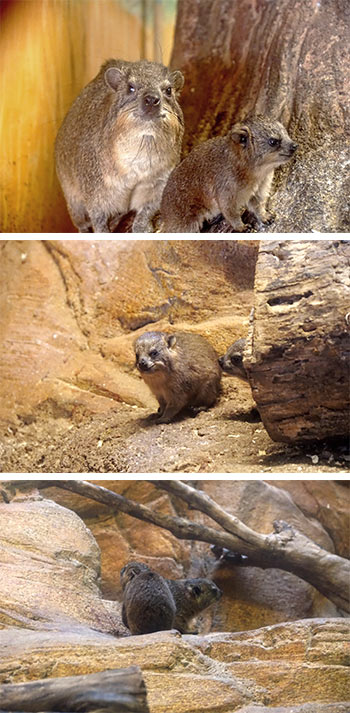Seeing double at Stone Zoo with birth of rock hyrax twins
Tuesday August 30, 2016
 Visitors to Stone Zoo will notice two new furry faces with the recent birth of rock hyrax twins.
Visitors to Stone Zoo will notice two new furry faces with the recent birth of rock hyrax twins.
The twins, whose sex is not yet known, were born in the early morning hours on August 25. Rock hyrax typically give birth to two to four pups after a seven to eight month gestation period. The birth is a first for Stone Zoo, which began exhibiting rock hyrax in 2013. The twins share their exhibit with their parents Paprika and Marco, both age four, as well as meerkats. The meerkats have not been on exhibit as the twins adjust to their surroundings.
“We are thrilled to share the news of these exciting births,” said John Linehan, Zoo New England President and CEO. “From birth, these animals are skilled climbers suited to rough, rocky terrain, and it’s amazing to observe the agility at such a young age. We have observed the babies climbing and exploring throughout the exhibit.”
While rock hyrax may resemble rodents, these small mammals weighing between eight to 12 pounds are actually distantly related to elephants. Their skulls, teeth and toes are similar in structure to an elephant, and they even have tiny tusks. Native to the rocky scrublands, desert and rocky outcrops in the rainforests of sub-Saharan and northeast Africa, as well as the Arabian Peninsula, these small mammals are well adapted to rocky terrain and can live in groups of 50 to 80 animals.
In the wild, rock hyrax do not stray too far from their dens when they forage and feed. When out of the den, these animals have sentries, which will issue a shrill cry to warn the others of danger. Rock hyrax, which have a squat build with a dense, light to dark brown coat, have a small dorsal gland which appears lighter than the rest of their coat. The odor secreted from this gland is used to communicate and mark territory.
Zoo New England participates in the Rock Hyrax Species Survival Plan (SSP), which is a cooperative, inter-zoo program coordinated nationally through the Association of Zoos and Aquariums (AZA). SSPs are designed to maintain genetically diverse and demographically stable captive populations of species. This birth is the result of a recommended breeding.
Photos courtesy of Dayle Sullivan-Taylor

